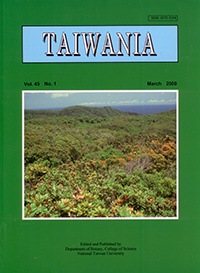Research Paper
Phylogeny of the Hylocomiaceae (Mosses, Order Hypnales) Inferred from Ontogenetic and Morphological Characteristics
Tzen-Yuh Chiang
Published on: March 2000
Page: 66 - 94
DOI: 10.6165/tai.2000.45(1).66
Abstract
The phylogeny of Hylocomiaceae is inferred by cladistic analyses of twenty-nine morphological characters and the ontogenetic sequences of paraphyllia, central strands, and axillary hairs. The entire ontogenetic transformations are recognized as characters, and character variation is polarized by outgroup comparisons. Two equally parsimonious trees produced by heuristic searches of PAUP support the monophyly of the Hylocomiaceae, which is closely related to family Hypnaceae, containing eight genera Hylocomium, Loeskeobryum, Leptocladiella, Hylocomiastrum, Neodolichomitra, Macrothamnium, Leptohymenium, and Orontobryum. Hylocomiaceae is diagnosable by sympodial growth-form, excepting Orontobryum. The genera Rhytidium, Rhytidiadelphus, Pleurozium, and Rhytidioposis are excluded from the Hylocomiaceae and comprise a monophyletic family, Rhytidiaceae. Based on the reconstructed phylogeny, homology is tested by Patterson's tests of similarity, conjunction, and congruence. In Hylocomiaceae erect leaves without plication and absent of foliose pseudoparaphyllia are found to be symplesiomorphies; at the infrafamilial level erect capsules with reduced peristomes are homologous (i.e., derived from a recent common ancestor). Homoplasies also provide useful insights into understanding the mechanisms of morphological evolution. A complementary methodology synthesizing adaptationist and structuralist perspectives is employed. Convergent evolution of paraphyllia in mosses is ascribed to environmental selection. The Bauplan of conducting tissue in mosses is attributed to functional constraints. Reversed evolution of central strands in Loeskeobryum is a manifestation of developmental constraints, which channel the variation of the ontogenetic pathway. Heterochrony by truncating (paedomorphosis) or extending (peramorphosis) the ontogenetic sequences is a common mode of morphological evolution in the Hylocomiaceae. The parallel evolution of axillary hairs by retention of juvenile morphology at the adult stage in Hylocomiastrum, Hylocomiopsis, and Actinothuidium or extending the terminal stage of ancestral state in Hylocomium, Gollania, and Rhytidium is ascribed to morphological constraints.
Keyword: Hylocomiaceae, Character concept, Cladistics, Monophyly, Ontogenetic transformations, Phylogeny.


